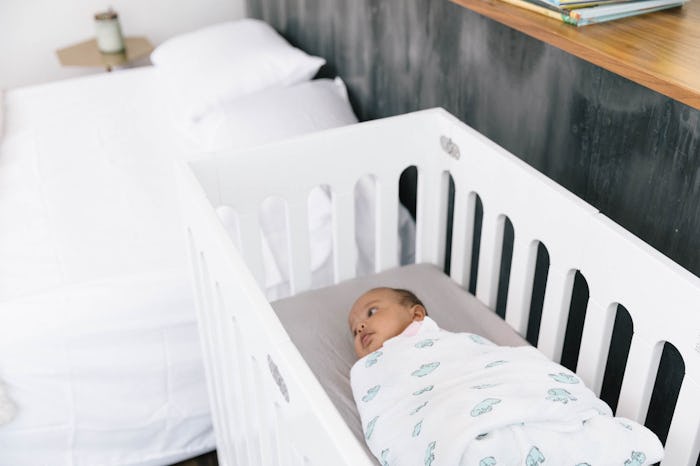When considering what sleeping arrangement will work best for their family, parents understandably do a lot of research into what the experts believe they should be doing. If you're anything like me, that means you're reading about co-sleeping. If you're not into bed sharing but still want the close proximity to your scrumptious new arrival, you're probably asking yourself, "Are co-sleepers safe?" while you peruse the latest Target options online.
The reality, and as reported by the National Public Radio (NPR), is that infants do sleep in beds with their mothers. So in 2016, the American Academy of Pediatrics (AAP) revised their infant sleeping recommendations to include safest sleep practices for co-sleeping families. Their bottom line is that no matter what sleeping arrangement is right for your family, infants sleep spaces should follow the safe sleep guidelines that include laying the baby on their back to sleep, clearing the sleep area of blankets, stuffed animals, and toys, and using a firm, bare mattress without crib bumpers.
It is not easy to find a conclusive answer to whether co-sleepers are safe or not. I suspect that is because there are multiple factors effecting co-sleeping safety in addition to the co-sleeper itself. The first thing to know about co-sleepers is there are several different types of commonly used co-sleepers (coincidentally, it seems that I've used them all). Most co-sleepers are limited to a certain age range or developmental milestone found in the manufacturer's instructions. These should always be followed for your baby's safety.
The small bed sharing co-sleeper, designed to fit between two safe and sober adults, is generally for babies under 5 months old or those who are not yet rolling over. When it comes to the safety of these small bed sharing co-sleepers, the AAP cannot recommend for or against these products. According to their national site, "there isn't enough research on bedside or in-bed sleepers. There have been no studies that have looked at their effect on SIDS or if they increase the risk of injury and death from suffocation.
A second co-sleeper option is the traditional bassinet, which comes in many forms. From portable and ground level, to raised foundations, adjustable, inclined, and often with automatic rocking features. The bassinet is a long-time favorite, possibly because of its ability to keep baby close while in a separate sleep space and thus making it easier to control for eliminating sleep space hazards. The downside of the bassinet is that it's only appropriate for the first few months, or until the baby begins to show signs of rolling over, according to the AAP. In other words, you'll have an adjustment period to a new sleeping surface that may be difficult for the entire family's sleeping routine at around 6 months.
The final and currently popular co-sleeper type are those that attach to but are separate from the parents' bed, such as the Arms Reach Co-Sleeper. As noted above, the AAP cannot make a recommendation for or against this type of co-sleeper. Infant sleep researcher, James McKenna, PhD, however, says:
The really good news is that over a million of these bassinets have been sold over the last fifteen to twenty years without one infant dying or being injured! There is no crib I can think of that has this safety record. The Arms Reach Cosleeper is, as it turns out, is about as safe as safe can be. And that’s why I so enthusiastically and proudly recommend them.
Nothing appears definitive in the question of whether co-sleepers are safe or not. The answer as to whether any one certain co-sleeper is safe for your baby will depend a lot on what is right for your specific situation and family. What does seem clear, however, is that following safe sleep standards, such as those offered by McKenna or the AAP, and ensuring your baby's sleep environment is hazard free will increase the likelihood of a positive co-sleeper outcome and help your family sleep safely and soundly.
